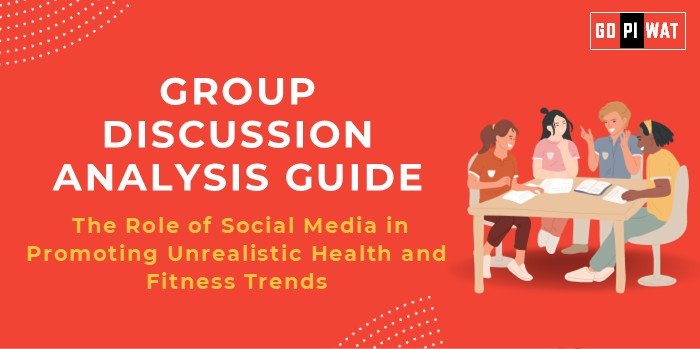📋 Group Discussion (GD) Analysis Guide: The Role of Social Media in Promoting Unrealistic Health and Fitness Trends
🌍 Introduction to the Topic
📖 Opening Context
Social media has become a key driver of health and fitness narratives, often projecting unrealistic body standards and diets. This trend impacts millions globally, influencing mental and physical health outcomes.
📜 Topic Background
Platforms like Instagram and TikTok showcase curated fitness lifestyles, which are often unattainable without significant resources or time. This phenomenon, while motivational for some, can perpetuate unhealthy habits and dissatisfaction.
📊 Quick Facts and Key Statistics
- 🌐 Global Social Media Users: 4.9 billion (2024) – Major influence on lifestyle choices worldwide.
- 📉 Diet Culture Content: 50% of Instagram’s top fitness influencers promote unverified products or routines.
- 🧠 Mental Health Impact: 32% of teens feel worse about their bodies due to social media (Pew Research, 2024).
- 💰 Market Size: Fitness apps reached $10 billion globally in 2023, showing the financial stakes of this trend.
🤝 Stakeholders and Their Roles
- 📱 Social Media Platforms: Content algorithms often promote trends that drive engagement but can reinforce unrealistic standards.
- ⭐ Fitness Influencers: Key figures in spreading trends, often without sufficient expertise.
- 🏥 Healthcare Professionals: Advocates for evidence-based approaches to fitness and diet.
- 👥 General Public: Active participants and consumers of fitness content.
🏆 Achievements and Challenges
✨ Achievements
- 📈 Increased Fitness Awareness: Encouraged exercise and healthy living among global audiences.
- 🤝 Community Building: Online support networks for fitness enthusiasts.
- 💻 Access to Free Content: Democratized basic fitness education through tutorials.
⚠️ Challenges
- 🌟 Unrealistic Standards: Leads to disordered eating and body image issues.
- 🔍 Lack of Regulation: Unqualified influencers spreading misinformation.
- 🧠 Mental Health Concerns: Social comparison and pressure to conform.
🌎 Global Comparisons
- 🇳🇴 Positive Example: Nordic countries promote body positivity and realistic fitness campaigns.
- 🇺🇸 Challenges in the US: Higher prevalence of influencer-driven fitness myths.
📖 Case Study
India’s rising fitness influencer culture has led to increased gym memberships but also higher rates of self-reported body dissatisfaction among youth.
💡 Structured Arguments for Discussion
- 👍 Supporting Stance: “Social media democratizes access to fitness inspiration, motivating millions to adopt healthier lifestyles.”
- 👎 Opposing Stance: “The prevalence of unattainable body ideals harms mental health and fosters unhealthy practices.”
- ⚖️ Balanced Perspective: “While social media promotes awareness, it must address the adverse effects of unrealistic health trends.”
📈 Effective Discussion Approaches
🔑 Opening Approaches
- 📊 Start with a statistic on mental health and social media.
- 📖 Discuss a recent viral fitness trend, highlighting its pros and cons.
🤔 Counter-Argument Handling
- 📉 Provide data on misinformation and suggest platform accountability mechanisms.
🔍 Strategic Analysis of Strengths and Weaknesses
- 🌟 Strengths: Large-scale reach, increased awareness, community building.
- ⚠️ Weaknesses: Mental health impact, misinformation, lack of inclusivity.
- 🚀 Opportunities: Partnerships with healthcare organizations to promote balanced content.
- ⚡ Threats: Rising cases of fitness-related disorders, legal scrutiny.
📚 Connecting with B-School Applications
- 🌐 Real-World Applications:
- 📋 Projects on digital marketing ethics or public health campaigns.
- 💬 Sample Interview Questions:
- 🧠 “How can platforms ensure balanced content?”
- 📜 “What role can governments play in regulating fitness misinformation?”
- 💡 Insights for B-School Students:
- 📊 Understand the impact of digital trends on consumer behavior.
- 📈 Explore public health policies influenced by digital platforms.


